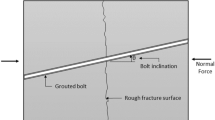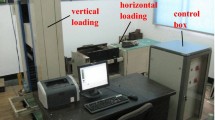Summary
This study proposes a new analytical model for the prediction of the contribution of bolts to the shear strength of a rock joint. The main characteristics of this model are the accounts for the interaction of the axial and the shear forces mobilised in the bolt, as well as the large plastic displacements of the bolt occurring during the loading process. The complete curve of the bolt contribution as a function of the displacement along the joint can be computed, and the maximum bolt contribution is obtained by dissociating the bolt cohesion and the confinement effects. The comparison of the performances of this analytical model with test results shows its capacity to describe the observed phenomena. The effects of the most important parameters such as bolt inclination, mechanical properties of bolt material, rock strength and joint friction angle are clearly established and discussed.
Similar content being viewed by others
References
Aydan, Ö. (1989): The stabilisation of rock engineering structures by rockbolts. Ph.D. Thesis, Nagoya University, Japan.
Azuar, J. J. (1977): Stabilisation de massifs rocheux fissurés par barres d'acier scellées. Rapport de recherche No 73, Laboratoire Central des Ponts et Chaussées, Paris, France.
Bjurström, S. (1974): Shear strength of hard rock jointed reinforced by grouted untensioned bolts. In: Proc., 3rd ISRM Congress, Denver, USA, 1194–1199.
Di Prisco, M. (1989): Sul comportamento a taglio delle barre d'armatura nel calcestruzzo. L'azione di spinotto: Risultati sperimentali e modellazione matematica. Doctorate Thesis, Politecnico di Milano, Italia.
Dight, P. M. (1983): Improvements to the stability of rock walls in open pit mines. Ph.D. Thesis, Monash University, Australia.
Egger, P., Pellet, F. (1991): Strength and deformation properties of reinforced jointed media under true triaxial conditions. In: Proc., 7th ISRM Congress, Aachen, Germany, 215–220.
Egger, P., Zabuski, L. (1991): Behaviour of rough bolted joints in direct shear tests. In: Proc., 7th ISRM Congress, Aachen, Germany, 1285–1288.
Ferrero, A. M. (1993): Resistenza al taglio di discontinuita' rinforzate. Doctoral Thesis, Technical University of Torino, Italy.
Gerrard, C. M., Pande, G. N. (1985): Numerical modelling of reinforced rock masses — I. Theory, computers and geotechnics, Vol. 1, 293–318.
Haas, C. J. (1981): Analysis of rock bolting to prevent shear movement in fracturated ground. Mining Engng. 33 (6), 698–704.
Hetényi, N. (1946): Beam on elastic foundation — Theory with applications in the fields of civil and mechanical engineering. The University of Michigan Press.
Holmberg, M. (1991): The mechanical behaviour of untensionned grouted rock bolts. Ph. D. Thesis, Royal Institute of Technology, Stockholm, Sweden.
Pellet, F. (1994): Strength and deformability of jointed rock masses reinforced by rockbolts. English Translation of the Doctoral Thesis 1169, Swiss Federal Institute of Technology, Lausanne, Switzerland.
Pellet, F., Egger, P., Ferrero, A. M. (1995a): Contribution of fully bonded rock bolts to the shear strength of joints: Analytical and experimental evaluation. In: Proc. 2nd Int. Conference on Mechanics of Jointed and Faulted Rock, MJFR-2, Vienna.
Pellet, F., Egger, P., Descoeudres, F. (1995b): A method for the design of a bolting system for rock slopes. In: Proc., 8th ISRM Congress, Tokyo.
Schubert, P. (1984): Das Tragvermögen des Mörtelversetzten Ankers unter aufgezwungener Kluftverschiebung. Doctoral Thesis, Montanuniversität, Leoben, Austria.
Spang, K. (1988): Beitrag zur rechnerischen Berücksichtung vollvermörtelter Anker bei der Sicherung von Felsbauwerken in geschichtetem oder geklüftetem Gebirge. Thèse de doctorat No 740, Ecole Polytechnique Fédérale de Lausanne, Switzerland.
Spang, K., Egger, P. (1990): Action of fully-grouted bolts in jointed rock and factors of influence, Rock Mech. Rock Engng. 23, 201–229.
Swoboda, G., Marenče, M. (1992): Numerical modelling of rock bolts in intersection with fault system. Proc. Numerical models in Geomechanics, NUMOG IV, Swansea, U.K., 729–738.
Author information
Authors and Affiliations
Rights and permissions
About this article
Cite this article
Pellet, F., Egger, P. Analytical model for the mechanical behaviour of bolted rock joints subjected to shearing. Rock Mech Rock Engng 29, 73–97 (1996). https://doi.org/10.1007/BF01079755
Issue Date:
DOI: https://doi.org/10.1007/BF01079755




